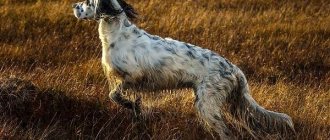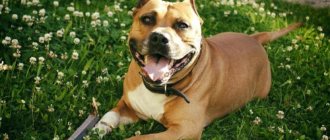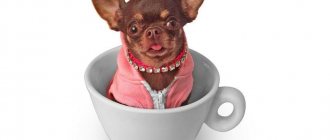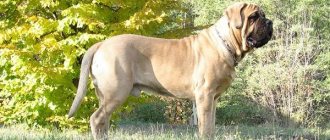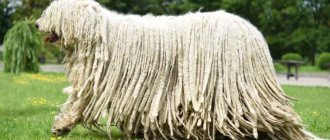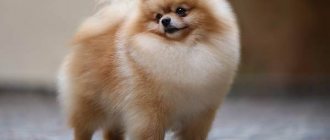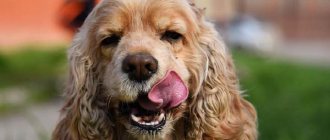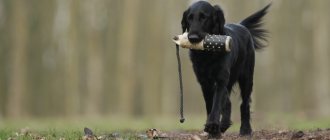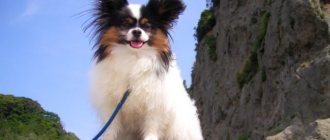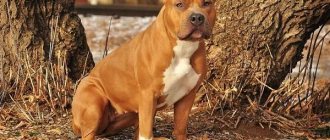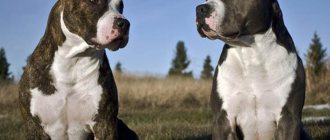Hunting dogs are a special caste of domestic animals, distinguished by their inherent habits, habits and temperament. You can’t expect them to perform security skills, and they won’t sacrifice themselves to save the life of their owner. Therefore, such dogs are not chosen as a protector.
However, in hunting they occupy a leading role - hunting dogs are able to sit in ambush around the clock and non-stop pursue game. Thanks to their impeccable sense of smell, they are able to smell prey several kilometers away, which almost always ensures that the hunter catches a trophy.
Types of hunting dogs - what are they?
Depending on the type of temperament, character traits, characteristics, capabilities and skills, varieties of hunting dogs are distinguished. Each type is used to hunt specific animals.
This is interesting! All breeds of hunting dogs are usually divided into 6 groups.
Hounds
The dignity of hounds lies in perseverance and obedience. Any type of hunting is possible with hounds, since they are well trained and clearly follow commands.
During the hunt, hounds are focused on the target and nothing can distract their attention. Their targets are bears, foxes, wolves, roe deer, deer, moose and wild boars.
- Russian hound
- Russian piebald hound
- Estonian hound
- Basset Hound
- Bloodhound
- American Foxhound
- English Foxhound
- Brazilian hound
- Porcelain hound
Burrows
This type of dog was specially bred for the purpose of catching small game that seeks shelter in the norm. They find living creatures by smell and, if the situation requires it, they pursue and fight with them.
Their main targets are badgers and foxes. Animals have ways of non-stop pursuing their prey, because they do not like to give in.
- Dachshund
- Jagdterrier
- Welterrier, or Welsh Terrier
- Fox terrier
This is interesting! The red fox is one of the most coveted prey for a burrowing dog.
Armory
Gun dogs participate in gun hunting. Animals are capable of sitting in ambush for a long time and chasing prey, covering tens of kilometers.
Used for hunting birds and small animals. The principle of operation is simple - the dog scares away the prey, and then, after the hunter shoots, finds and brings it to the owner.
Cops
A hunting dog, a cop, chooses feathered game as prey. Their task is to catch or scare birds so that, when they fly into the air, they fall into the sights of a hunting rifle. They then go out to find the bird and deliver it to its owner.
- English pointer
- English Setter
- Burton epañol
- Small Munsterlander
Retrievers
According to the FCI standard, dog breeding has established that the retriever is a gun dog. Its main task is to find game birds and put them under the gun. Like pointers, retrievers, after a successful shot from a hunter, must deliver the trophy.
- Golden retriever
- Curly coated retriever
- Labrador Retriever
- Nova Scotia Retriever
- Flat-Coated Retriever
- Chesapeake Bay Retriever
Spaniels
Like the previous two types of gun dogs, spaniels are used to catch feathered animals. The main targets of spaniels are: swamp (snipe, snipe), field (partridge, quail, corncrake), pine (grouse, black grouse, woodcock) and waterfowl (duck) birds.
The operating principle is the same. The dogs search for birds, pick them up and then deliver them to the hunter.
- English cocker
- English springer
- American Spaniel
- American Water Spaniel
- Dutch Spaniel (Koikerhondje)
- Irish Water Spaniel
- Clumber
- German Wachtelhund
- Russian hunting spaniel
- Welsh (Welsh) Springer Spaniel
Likes
Laika is a native hunting breed of dog, originally from the cold North. They show particular assertiveness in their work and do not give up on their goals. Suitable for catching any, even large, game.
- Russian-European Laika
- East Siberian Laika
- West Siberian Laika
- Karelo-Finnish Laika (or Finnish Spitz)
- Nenets Laika (reindeer spitz)
- Yakut Laika
Greyhounds
The greyhound's mission when hunting is to drive down, exhaust the prey, and then make a graceful leap and then deliver the defeated animal to the hunter. It is worth noting that even in the most fierce battle, they do not tear the trophy, so as not to spoil the appearance of its skin.
Hunting with dogs is carried out for hares, rabbits, foxes, wolves and roe deer. Often their target is young deer.
- Russian greyhound
- Azawakh
- Whippet
- Saluki
How to choose the right puppy
To select a future reliable puppy you need:
- know the characteristics of behavior;
- consider different options depending on your hunting goals;
- choose a nursery;
- exclude genetic defects by veterinary examination.
The puppy must be active, cheerful and brave. Excessive cowardice or aggressiveness is excluded.
The competent choice of a dog for the hunter’s goals is a real science that is not difficult to comprehend. It is important to follow simple rules and count on the breeder’s integrity. A defective dog is a huge set of problems.
Training should be carried out by an experienced dog breeder who is able to maintain character, show perseverance, and attention to the future assistant.
Smooth-haired hunting dogs
Smooth-haired dogs have a number of advantages:
- during seasonal molting, the coat change is less noticeable;
- no special care is required for the fur;
- the owner will not have to deal with the problem of combing out tangles.
Typical representatives:
- Smooth-haired dachshund;
- Pharaonova;
- Rabbit Dachshund;
- Estonian hound.
Advantages and disadvantages
Every breed has its positive and negative aspects.
Hunting breeds differ:
- special character, emphasizing activity, obedience, dependence on the owner;
- wool does not require special ongoing care;
- are able to understand a person’s words;
- They are friendly towards their relatives.
Negative aspects are associated with the instinctive desire to run a lot, sniff, and search. They need constant physical activity. Suitable only for those owners who are willing to tolerate the antics of the “hunter”. Keeping them in an apartment becomes problematic for many due to the ringing, trumpet-like or deafening bark that turns into a howl.
Long-haired hunting dog
Caring for a long-haired four-legged friend is always challenging. The period of seasonal molting is considered especially difficult.
Typical representatives:
- Longhaired Golden Retriever;
- Irish Hunting Dog;
- Royal Afghan Hound;
- Irish Water Spaniel;
- Kerry Blue Terrier.
Important! A dog's curly coat is considered the most difficult to care for.
Retrievers
Long-haired hunting dogs, which date back to the 19th century, are intelligent, friendly, loyal and reliable. They perform especially well when hunting birds.
Golden retriever
One of the cutest and kindest canine animals. He is bred as a companion dog, but the blood of a hunter flows in the blood of a retriever. He is affectionate and attentive with his family members and his master's pets.
A dog always senses when its owners are in a bad mood. In this case, she tries in every possible way to console them, for example, putting a sad face on her lap or poking her nose approvingly. Thanks to this behavior, the dog began to be used in psychotherapy.
People who are in a state of neurosis or depression can spend time with him, after which they feel a little better. And the hunting instincts and excellent sense of smell made the golden retriever a rescue and search dog. It is used by the police to search for drugs.
You should not expect such a dog to display protective qualities. The retriever will warmly welcome every person who comes to his home, even if it is an intruder. Aggression is alien to him. These cute animals have bright thick fur, a long fluffy tail, a slender body and very kind eyes.
Curly (curly-coated retriever)
An excellent swimmer with a soft grip, which is valuable in duck hunting. Curlies need constant movement. dege and active games.
Toller (Nova Scotia Retriever)
Toller has the gift of luring game birds into the hunter's line of fire, for which they are often called "duck whisperers." Dogs are smart and easy to train. Nova Scotia Retrievers are medium-sized, robustly built, and fiery in color. Does not tolerate loneliness and lack of attention.
Small breeds of hunting dogs
Small dogs often realize their potential in burrow hunting. Such animals combine obedience, loyalty and a friendly attitude towards the owner. Also, such pets are useful in catching white hares, black grouse, and also in catching ducks from the water.
Typical representatives:
- Fox terrier;
- Cairn Terrier;
- Norwich Terrier;
- Smooth-haired dachshund;
- Beagle;
- Italian greyhound;
- Hungarian Vizsla.
Hounds
The group includes many breeds. Tracks prey by scent, and then pursues it to the hunter or dead end.
Russian hound
The animal really needs regular exercise. Without them, his strong muscles will slowly atrophy. This is a Russian hunting dog breed with a well-developed sense of territoriality.
She is distinguished by devotion, observation and endurance. Intolerant towards other animals (especially cats). In order for a Russian hound to be friendly towards the rest of its owner’s pets, it should be introduced to them as a puppy. In this case, she will have no choice but to get used to them. This breed is not one of the large ones. Its height is 60-65 cm.
The dog is distinguished by amazing intelligence, its training is simple and interesting. Already from the third time she will begin to carry out the command without prompting from the owner. Remember, if you lead a sedentary lifestyle and prefer to spend most of your time in solitude, then the Russian Hound is not your option. She is very mobile, playful and active, so she needs frequent walking. In addition, the animal becomes strongly attached to its owner and needs to spend time with him regularly.
Estonian hound
A calm and balanced dog that quickly becomes attached to people. Caring for her is not only simple, but also pleasant. The animal is distinguished by trust and tenderness towards the people living with it. The calm nature will allow this breed to stay in a dog hotel for a long time. If the owner, for example, is forced to go on a business trip or vacation with his family.
The Estonian hound is a good hunter. She cannot boast of an impressive size, long legs or a slender body, but she barks loudly and melodiously, notifying her owner of the presence of prey in the area.
With the wrong approach to training, an animal can become stubborn and dominant. It is important to correct his behavior by condemning bad actions. For example, if an Estonian hound, as a puppy, tries to gnaw at your legs, you can lightly hit it on the nose with a rolled-up newspaper, while saying “Ugh” in a serious tone. By the way, this is one of the basic words used in raising dogs.
Basset Hound
The breed was bred to hunt small animals, especially forest rabbits and hares. The Basset Hound does not have such a slender body as the English hound, it cannot boast of such endurance as the Weimaraner, but the breed has other advantages that allow it to occupy an honorable place among hunting dogs.
First of all, she is very affectionate. The animal adores its owners, preferring to spend time being close to them. It loves stroking and scratching. In the absence of tactile contact with the owner, the Basset Hound becomes upset and depressed. Secondly, he has excellent hearing. The dog can hear even a very quiet rustling in the forest thanks to its huge ears. She is moderately active and inquisitive.
Thirdly, the Basset Hound is tolerant of other animals; he will never show aggression towards a dog or cat if he encounters them while walking. But he tries to be friends with the owner’s pets. As for the disadvantages of keeping it, there are practically none, with the exception of one thing - difficult training. A beginner will not be able to cope with the stubborn nature of the Basset Hound.
Beagle
A very cheerful breed suitable for a family, loves people and company. The breed was bred to hunt rabbits and hares. Beagles need daily exercise.
Rhodesian Ridgeback
African Lion Dog, bred to hunt large cats. A well-built, muscular dog, but with a calm and balanced character. The Ridgeback is amazingly loyal and will become a companion to its owner in any activity; long, active games are required.
Large hunting dogs
Large breeds of hunting dogs are designed to track game and large animals. They are able to chase prey for several hours on end without experiencing fatigue. As a rule, a large dog is distinguished by a balanced temperament and devotion.
Typical representatives:
- Swedish Husky;
- Bloodhound;
- Russian greyhound;
- Greyhound.
Knowing what types of hunting dogs there are, choosing a breed suitable for a particular job will not be difficult. If hunting is carried out at any time of the year, then it is best to purchase a universal four-legged friend.
Dachshunds
Small hunting dogs used for hunting burrowing animals and more. They can freeze in a stance when tracking, and are distinguished by their keen sense of smell and intelligence.
Wirehaired dachshund
The wire-haired dachshund has a hard coat with a soft undercoat and is not afraid of frost. The dog has good hunting qualities. He works judiciously and never sacrifices himself for the sake of production. They successfully fight with burrowing animals, willingly go into the water and feed any game.
Smooth-haired dachshund
Smart and quick-witted dog. He cannot go on long walks with his owner without attention. The dachshund is a burrow hunter and its appearance is associated with this feature. It has an elongated body and disproportionately short legs. Colors can be varied.
Rabbit dachshund
The smallest representative of dachshunds. It is used for hunting small burrowing and fur-bearing animals, and is capable of penetrating their difficult-to-pass burrows. Due to its size, unpretentious and affectionate nature, it is perfect as a pet, which can be kept even in an apartment, subject to regular walking.
Weimaraner
The breed is designed for hunting large animals. The dog is also used when catching all game birds. The Weimaraner easily switches from one victim to another.
The Weimaraner is easy to train. Dogs are distinguished by obedience, sensitivity, and good intelligence. The breed is not aggressive, but is wary of strangers.
The Weimaraner is able to sense the mood of its owner, and it is important for him to constantly maintain contact with him. The dog is unpretentious in care: he is content with primitive conditions and simple food. At home, the dog is friendly and gets along well with children.
Breton epañol
The pointing breed was bred by the French and was intended for hunting birds that live in the mountains and fields. The Breton Spaniard lends itself well to training, regularly following all the commands of the owner. It is easy to train him to hunt if the task is clearly defined.
The dog has a friendly disposition, high intelligence, energy, sociability and hard work. The Breton Spaniel is not aggressive towards strangers. Representatives of the breed love to please their owner, surprising them with their resourcefulness.
Border Collie
Main characteristics:
- Height at withers: 45-55 cm.
- Weight: 15-22 kg.
- Coat, color: according to the standard, the Border Collie's coat is of two types: short or medium length; the color can be different, but white color should not predominate.
- Temperament and other personal qualities: intelligent, energetic, loving
- Life expectancy: 10-17 years.
Border collies are perhaps the most famous "herders" in the world. And this is not surprising, because they are very smart and hardworking. Work is the main meaning of their life.
The origins of the Border Collie can be traced back to Roman times. When the state fell, the Vikings attempted to invade Britain. During their hikes, they were often accompanied by small and agile Spitz-like dogs that knew how to herd cattle. It is believed that these dogs are the ancestors of the border collie.
High intelligence, irrepressible energy and the desire to work and learn make these dogs as flexible as possible in matters of training.
Border Collies require a lot of mental stimulation and daily exercise.
Interesting Facts:
- The Border Collie is the smartest breed.
- A representative of the breed named Chaser is considered the smartest dog in the world. She could recognize more than 1000 words. The dog died in 2022 at the age of 15.
Drever
The Drever, a breed of dog similar to the dachshund, was bred specifically for hunting roe deer, wild boar, foxes and hares by crossing the dachshund with a Swedish hunting dog. Representatives of this breed are distinguished by an excellent sense of the animal, endurance and tenacity in its pursuit and the ability to hold prey in place until the hunter shoots. They successfully hunt both alone and in a pack of dogs.
Although drevers do not run as fast as other hounds, this disadvantage is compensated by their determination, hard work and sonorous voice.
Appearance
Description:
- The Drever is a dog endowed with a long, strong, muscular body on short legs. The distinctive properties of the physique also include a flat back and a protruding, elongated chest. The drever has a tucked belly and a long, saber-like tail. The height of the dog at the withers reaches 38 cm.
- The head of the drever is large and long with a weakly defined transition from the forehead to the muzzle. The breed is characterized by medium-sized ears, set high and falling to the sides.
- The coat is uneven in length in different parts of the body. On the neck, back and buttocks the hair is hard and long, on the inside of the tail it is fluffy. There are representatives of the breed with different coat colors, but always with white symmetrical spots.
Character and temperament
Drevers are endowed with many qualities necessary for a hunter - attentiveness, restraint, insight, self-confidence, courage and energy. They are not characterized by aggressiveness and unpredictability.
The breed is distinguished by high mental abilities, so it lends itself well to training and education. The character of the Drever is dominated by amiability, goodwill and an affectionate attitude towards household members.
Artesian-Norman Basset
Artesian-Norman Basset Hounds are a breed of hounds that have excellent sense of smell and are able to quickly track down an animal in any conditions. Dogs of this breed, having discovered an animal, methodically pursue it with their voices, while overcoming dense thickets, and having driven it in, they take it out of any narrow and deep hole. The Artesian-Norman Basset breed has proven itself in hunting not only hares and rabbits, but also larger animals - foxes and wild boars.
Appearance
Description:
- The dog's body is powerful and harmoniously built; it is an elongated body with a strong, wide back, a slightly flattened lower back and a long oval chest. The height of an adult is approximately 36-37 cm, and the weight is no more than 15 kg. The breed is characterized by a long neck with a slight dewlap and short, strong, slightly curved legs.
- The dog's head looks massive in relation to the body due to the large convex skull. The muzzle features a slightly convex bridge of the nose and an upper lip that practically covers the jaw. Large oval-shaped eyes express a calm and affectionate look. This breed is distinguished by soft, long ears, narrow and tightly curled at the base and pointed at the tips.
- The dog's coat is short, bristly-like, close to the body and usually has a tricolor color: light brown, black, white.
Character and behavior
The Artesian-Normandy Basset has the character of a real hound, succumbing to the excitement of the hunt. He is capable of learning and can be a reliable human assistant in hunting any animal. However, he cannot be called an overly obedient dog.
On the hunt and at home, he can be stubborn and headstrong. The dog has a good disposition, she gets along well with people and is not prone to aggression.
Beagle
The Beagle dog is one of the oldest and smallest hounds of hunting dogs with the instinct to follow a scent and dig holes. Since ancient times, both foot and horse hunters have hunted hares with beagles. The track record of these dogs includes hunting deer, wild boar and even jackals. Beagles also do an excellent job of delivering dead birds.
Appearance of the breed
Description:
- The Beagle's physique is strong, with well-developed bones and good muscles, and an elegant body of medium length. He has a wide chest and a slightly retracted belly. The height of a beagle ranges from 33 to 40 cm, and the average weight of an adult dog ranges from 8 to 13 kg. Dogs of this breed are characterized by: an elongated curved neck, muscular paws, a well-furred and high-set tail. The dog's skin is elastic and fits tightly to the body.
- The dog's head is massive and slightly elongated. The muzzle is distinguished by a wide black nose with large nostrils, drooping lips, large dark brown eyes and strong jaws. The long ears, rounded at the ends, fit closely to the cheeks.
- The Beagle's coat is thick, short and sharp to the touch with the breed's characteristic tri-color color - white with large brown and black spots.
Character and behavior
The main character traits of the Beagle are its cheerfulness, friendliness, activity and devotion to its owners. He is characterized by extraordinary intelligence, a lively mind, and the ability to quickly make decisions. This is an independent and confident dog with a balanced and active behavior.
She doesn't have fear. The Beagle has a loud, booming bark that attracts attention and drives away unexpected guests. The dog, possessing inexhaustible energy, can hunt and play tirelessly.
Yorkshire Terrier
The Yorkshire Terrier is an indoor decorative dog that is currently popular. The little ones, originally from England, evoke affection at first sight. They first appeared in the north of the country, on peasant farms, where they repelled rodents and accompanied peasants on business trips. Then the common people were forbidden to keep large pets capable of hunting on the landowners' lands.
Indoor decorative dog
This is one of the smallest English dog breeds - the photo conveys the diminutiveness of the Yorkshire Terrier, which is hiding headlong in the tall grass. According to the standard, body weight should not exceed 3100 g, any height. The coat is long, thin and shiny, without clipping it falls evenly and straight down the sides to the floor. There is no undercoat, only a coat, like a human's. Therefore, hair practically does not fall out, except when damaged or intensively combed. The absence of shedding benefits family members prone to allergic reactions. Furniture and carpets remain clean.
The color is silver-blue or golden-red-brown, in various combinations. Standardization is difficult, although experts have tried to describe in detail the main exterior options. Light Yorkshire Terriers are the result of crossing with lap dogs; such hybrids have the silkiest fur. Dark dogs have wavy hair, slightly curly in contrast to the straight hair of lapdogs.
Important: Yorkshire Terrier puppies are born almost black. This is not a deviation from the norm; with age, the fur becomes lighter, starting from the head.
Only uncut pets participate in exhibitions. In everyday life, floor-length hair gets in the way, so it is collected in curlers. For walks, wear overalls on the body and special socks on the paws. At the top of the head, the bangs are twisted into a ponytail or top knot. It is not necessary to dock the tail according to the new standards; this issue is left to the discretion of the owners.
Yorkshire Terriers are in great need of their owner's attention. Ready to constantly follow a person, at least in their arms or in a carrying bag. A hunting instinct has been developed, which is why pets, on occasion, eat insects that have fallen from the nest of chicks and rodents abandoned by predators. You need to monitor this and select unwanted prey in a timely manner. It is better to protect puppies from children, since a child can accidentally injure a tiny baby.
English Setter
Brief characteristics:
- Height: 58-68 cm.
- Weight: 20-36 kg.
- Coat and color:
- Temperament: soft, affectionate.
- Life expectancy: 10-12 years.
There is evidence of the existence of English setters as far back as 500 years ago. These elegant dogs were developed by crossing excellent hunting dogs: Springer Spaniels and Spanish Pointers. The result is a stunning spotted puppy with an affectionate disposition.
Experts say these dogs are smaller and gentler than their Irish and Scottish Setter counterparts, making English Setters incredibly loyal and lovable pets.
English Springer Spaniel
A brief description of:
- Height: about 50 cm;
- Weight: approximately 20 kg;
- Coat and color: long coat (thicker on the chest, ears, belly and legs), color – white with black, coffee or brown spots;
- Life expectancy – from 12 to 14 years;
- Loving, teachable, fun.
The English Springer Spaniel is the true embodiment of the Spaniel spirit. These dogs are full of energy, hardworking and affectionate. The “Englishman” is balanced and extremely diligent in his work. At the same time, he is sociable, obedient and affectionate. Like English setters, these dogs have helped hunters in their difficult task for centuries.
Spaniels were bred centuries ago to track game in mountainous areas. They were best at driving birds out of their nests, allowing hunters to shoot their prey. By 1902, the English Springer Spaniel was officially recognized in England.
Today's Springer is a hardy dog with an unbridled zeal for work. Representatives of the breed always strive to please the owner, so training never becomes a problem for these smart and flexible dogs.
Interesting Facts:
- Springer spaniels got their name due to their hunting technique: the dogs seem to “jump” towards the game.
- American President George H. W. Bush had a springer spaniel named Millie.
- At some point, the springer spaniel and cocker spaniel were classified as one breed.
Terriers
Burrowing, short-haired hunters of small rodents. Terriers are very attentive and can track prey by smell.
Jack Russell Terrier
This is a small hunting dog that is in no way inferior to its larger brothers. She has a suspicious and wary look. The Jack Russell Terrier, despite its diminutive size (weight up to 5 kg), is a very hardy and strong dog. It was bred to hunt foxes.
This breed is not suitable for beginners, as it is not easy to tame its stubborn temperament. In addition to her difficult character, she has several other disadvantages: severe shedding at different times of the year, excessive activity and curiosity, as well as an increased need for physical activity and attention of the owner. The Jack Russell Terrier cannot stand loneliness; he cannot remain alone for a long time, as he wants to spend all the time next to his owner.
Extraordinary devotion is not his only virtue. This dog is smart, quick-witted and very resilient. It is easy to care for. Important! It is not recommended for gardening enthusiasts to own a Jack Russell Terrier because of his tendency to dig holes everywhere.
Airedale
The appearance of the animal is unusual and interesting. The Airedale Terrier is a hunting dog in the photo that looks like a children's toy. She has medium-sized curly fur of a very bright, often red-black, color. It's even on the dog's face. Its small ears are slanted and there is a large black nose at the tip of its muzzle.
Some breeders call the breed the “queen of all terriers.” This is not due to arrogant behavior, but to large size. The Airedale Terrier is the largest and most massive of all known terriers. Interesting! During World War II, the dog was used as a messenger. He did his job very well.
The dog loves to play with children. She does not need frequent hunting trips, like, for example, a Greyhound, since she likes communication with people. In addition to well-developed social skills, the Airedale Terrier boasts outstanding intellectual abilities. He learns commands very quickly and never loses trust in his family members. Loyalty and fearlessness made him a good guard and watchman.
Jagdterrier (German hunting terrier)
A strong, hardy dog that adapts to any working conditions. Thick mustache and eyebrows on the muzzle protect the nose and eyes when in the hole. The Jagdterrier can fearlessly fight a badger that is larger than it. They can serve the bird in the manner of a spaniel without a stand, and willingly go into the water.
Basenji
A peculiarity of the breed is that at a moment of irritation or anxiety, the dog makes rumbling sounds instead of barking. Dogs have smooth muscles, so they move freely and coordinate their movements well.
The Basenji is distinguished by its mobility, energy, willfulness and excellent hunting skills. In pursuit of game, the dog can ignore the owner's commands.
Representatives of the breed are friendly and sociable. They get along well with people and other pets.
